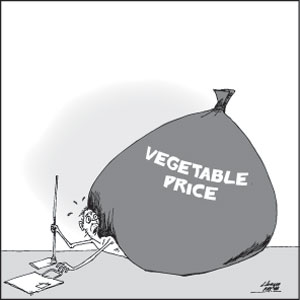News
Price volatility puts veggies beyond reach once more
 Prices of vegetables have rocketed once again and farmers suspect middlemen are responsible, while weather-watchers say the ‘La Nina’ phenomenon which caused heavy rainfall, has also been a factor.
Prices of vegetables have rocketed once again and farmers suspect middlemen are responsible, while weather-watchers say the ‘La Nina’ phenomenon which caused heavy rainfall, has also been a factor.
Pumpkin, ash gourd, luffa, bitter gourd, aubergine, ash plantains, and green chilli have become unusually costlier.
Vegetable grower, Suranimala, 39, of Udawelayayagama in Sigriya, said supply had dwindled because three months of rain from November to January destroyed some crop such as beans, ladies’ fingers, long beans, green chilli, and capsicum.
“I have lost about Rs. 80,000,” he lamented. Wild elephants too, had destroyed his manioc cultivation, he said.
Earlier, he had grown big onion and suffered a loss of Rs.850,000 due to rains. “Onions need moderate rain,’’ he said.
“Now I have a chili cultivation,” he said, adding that April rains could cause harm. He is also worried that prices could drop. “If the current prices prevail, we could survive.”
However, he could not explain what caused the prices of items such as ash plantains, banana blossoms (kesel muva), manioc, and so on, to rise.
“These prices might have been manipulated by middlemen,” he said, blaming wholesale traders.
Wholesale vegetable dealer Mr. E.M.U.B Ekanayaka, who owns Samanala Traders at the Dambulla Special Economic Centre, said produce had been arriving.
“Now, the prices are falling,” he said compared with a week earlier.
 Beans sell wholesale at Rs. 120-Rs 130, cabbage is Rs. 30-Rs 40, tomato Rs. 150-Rs 160, aubergine Rs. 100-Rs 120, ash plantain Rs. 50-Rs 60, long beans Rs. 80-90, ladies’ fingers Rs. 120, and pumpkin at Rs. 110-Rs 120 a kilo.
Beans sell wholesale at Rs. 120-Rs 130, cabbage is Rs. 30-Rs 40, tomato Rs. 150-Rs 160, aubergine Rs. 100-Rs 120, ash plantain Rs. 50-Rs 60, long beans Rs. 80-90, ladies’ fingers Rs. 120, and pumpkin at Rs. 110-Rs 120 a kilo.
“Prices of all kinds of vegetables were more than Rs. 200 a kilo,” said Mr. Ekanayake, referring to a week earlier. “A kilo of brinjals was sold above Rs. 300 and chili sold at Rs. 800 a kilo.’’
He said large vegetable cultivations had been destroyed because of heavy rains in December and January.
Shantha and Anjana, a father and son, who grow vegetables in Meepilimana, in Nuwara Eliya, said rains from December to February ruined their crop.
They also accuse big traders and farmers of manipulating vegetable prices.
“Since they have large cultivations of 50 or 100 acres of vegetables they can set prices. They manipulate prices.”
They also accuse the big players of buying up imported potato seed, leaving little for small farmers.
Local seeds available through government farms are low yielding, they said.
According to Shantha and Anjana they could sell to wholesale traders carrot at Rs. 110 a kilo, cabbage Rs. 60, leeks Rs. 70, potato Rs. 105, radish Rs. 30, beetroot Rs. 110, and beans Rs. 90, on Thursday.
The Gannoruwa National Agriculture information and Communication Centre, information director, Mr. Hiran Peiris, said that the ‘La Nina’ weather phenomenon had affected some vegetable cultivations in the past few months.
But, he said, he could not explain the higher prices of some vegetables.
He also suspects price manipulation by middlemen. Mr. Peiris believes prices would begin to gradually drop from the end of this month.
Met Department duty meteorologist, Mr Kasun Pasqel, said the increase in rainfall during the eastern monsoon was due to the ‘La Nina’ phenomenon. The increase in the rainfall has not been measured, he said.
| Supply drops in hills By Shelton Hettiarchchi Nuwara Eliya famers have switched to growing potato after harvesting their vegetable crop. Demand for vegetables has dropped at the Nuwara Eliya Economic Centre due to the coronavirus pandemic. “Now the centre has resumed operations and prices have gone up,” an official at the centre, said. At the centre, cabbage is being bought at Rs. 70 a kilo, carrot Rs. 150, leeks Rs. 85, radish Rs. 70, potato Rs. 120, salad leaves Rs. 150, tomato Rs. 100, Cauliflower Rs. 800, and knolkhol Rs. 130. | |


